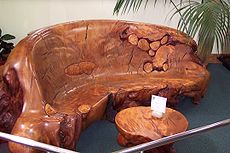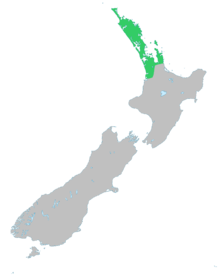New Zealand Kauri Tree
| New Zealand Kauri Tree | ||||||||||||
|---|---|---|---|---|---|---|---|---|---|---|---|---|

A New Zealand Kauri tree ( Agathis australis ), the " Tāne Mahuta " |
||||||||||||
| Systematics | ||||||||||||
|
||||||||||||
| Scientific name | ||||||||||||
| Agathis australis | ||||||||||||
| ( D.Don ) Loudon |
The New Zealand Kauri tree ( Agathis australis ), and New Zealand kauri pine or New Zealand kauri pine called, is a plant from the kind of Kauri trees ( Agathis ) in the family of Araucariaceae (Araucariaceae). It is the largest tree species native to New Zealand .
description
The New Zealand Kauri tree is an evergreen tree that today usually reaches heights of 30 to 50 meters and a trunk diameter of 1 to 4 meters. Specimens felled in historical times achieved much larger diameters. The supposedly largest kauri tree, reported in a 1919 report, is believed to have existed in Tararu Creek on the coast near Thames on the Coromandel Peninsula in the 1870s and had a trunk diameter of 8.54 meters and a circumference of 26.82 meters and were about 4,000 years old. The largest kauri tree alive today is the Tāne Mahuta .
The alternate to almost opposite leaves are broad and have parallel veins.
The New Zealand Kauri tree is single-sexed ( monoecious ); there are male and female cones on a tree. The male cones standing on a stem are cylindrical and 2 to 5 centimeters long. The female cones, which stand on a short stalk and only mature after two years, are blue-green, almost spherical and have a diameter of 5 to 7.5 centimeters. The cone scales are 1.8 inches long. It takes 19 to 20 months from pollination in October to seed maturity. The seeds are spread by the wind.
In its youthful form, the tree grows conically with branches distributed over its entire length. In old age it sheds the lower branches and forms an umbrella-shaped crown. At this stage it towers over the other trees in the forest.
The bark peels off in flakes so that epiphytes cannot settle permanently.
The wood of recent Kauri trees has a density of 560 kg / m 3 at 12% moisture , a breaking point of 88 MPa and an elongation point of 9.1 GPa. The strength values of marsh kauri are lower. When drying to 12%, the wood shrinks tangentially by 4.1%, axially by 2.3%.
distribution
The home of the New Zealand Kauri tree is in the northern part of the North Island of New Zealand .
In the Jurassic Age , there were species of the Araucaria family (Araucariaceae) as the first ancestors of the Agathis species.
use

The wood of the Kauri is straight grained, easy to work with and is still very stable.
With the beginning of the settlement of New Zealand by European settlers , the stock of Kauri forests was severely decimated. The trees were ideal for shipbuilding because of the high number of branches and their strength. In addition, the wood was used to build houses, for furniture and wall paneling, fences, as construction timber, for barrels, vats and basins, railway sleepers, supports in mining, carving and turning work and other purposes.
The rootstock and crown of the tree provide a beautifully grained wood that was used for furniture and paneling.
Today the New Zealand kauri tree is under nature protection and may only be felled by the Māori for ritual purposes .
Nevertheless, products made from kauri wood can be bought today . However, these come from so-called swamp kauri. The formerly marshy ground has sunken cowries for up to 50,000 years preserved . These are dug up again and processed. Items made from this wood are exclusive and expensive.
The Kauri provides a tree resin , the Kauri resin , a form of the copal .
Kauri in Māori mythology
The kauri in general, but especially a few selected specimens in particular, play an important role in Māori mythology .
Tāne , the god of the forest, is in the Māori cosmos the son of Rangi and Papa , Heavenly Father and Mother Earth. Tāne pushed apart his parents, who were closely embraced in love and thus left the earth in darkness. Thereby he brought light, space between heaven and earth and air to breathe to the earth. Tāne is then the bringer of life, all living creatures are his children.
Other very large and ancient kauri trees also play an important role in the identity of the Māori. This is also the reason why numerous efforts to replant the kauri have also been started on Māori land.
The most famous living specimens
Tāne Mahuta - Lord of the Forest
The Tāne Mahuta or Lord of the Forest , as it is called in New Zealand, is New Zealand's largest known living kauri tree. This specimen has a total height (with crown) of 51.2 meters with a trunk circumference of 13.77 meters. The trunk height from the ground to the base of the crown is 17.68 meters, the trunk volume 244.5 m 3 .
The age of the Tāne Mahuta is estimated to be around 1500–2000 years, making it the oldest (known) kauri. In New Zealand, however, there are local guides who tell of an even older tree, which, however, should not be open to the public for its protection. However, no statement on this has yet been published in the literature.
Te Matua Ngahere - Father of the Forest
The Te Matua Ngahere has a total height (with crown) of 29.9 meters and a trunk height from the ground to the crown approach of 10.21 meters. With a trunk circumference of 16.41 meters, this is the specimen with the largest circumference. The trunk volume is 208.1 m 3 .
Other known specimens
- Four Sisters
- Yakas
- Square Kauri (Coromandel Peninsula)
Systematics
The first description of this species took place in 1803 under the name Dammara australis by David Don in Aylmer Bourke Lambert : A Description of the Genus Pinus , 1st edition, volume 2, p. 14. The classification in the genus Agathis took place in 1829 by John Claudius Loudon in An Encyclopedia of Plants , p. 802. A homonym is Agathis australis Steud. published in Nomenclator Botanicus , 2nd edition, 1841, 1, 34. Another synonym for Agathis australis (D.Don) Loudon is Podocarpus zamiifolius A.Rich.
Protection and threat
The kauri is seriously threatened by the fungus Phytophthora agathidicida . It causes root rot that can lead to the death of the trees. The so-called kauri dieback or kauri dieback can currently only be stopped by preventing the fungus from spreading. Therefore there are disinfection stations in front of forest areas with cowries where hikers are encouraged to clean their shoes. In addition, paths must not be left and hikers should under no circumstances step on the roots of the kauris.
museum
The Kauri Museum in Matakohe focuses on the extraction of Kauri wood and Kauri resin. In addition to numerous machines and devices, it also exhibits the world's largest collection of Kauri resin and numerous exhibits made from Kauri wood.
photos
Male cone
Web links
- Christopher J. Earle: Agathis australis. In: The Gymnosperm Database. May 24, 2011, accessed on October 21, 2011 (English, section description and systematics).
- Tourist information on the Kauri coast. (German and English)
Individual evidence
- ^ Josie Dew: Long Cloud Ride: A 6,000 Mile Cycle Journey Around New Zealand . Little, Brown Book Group, 2008, ISBN 978-0-7515-3584-6 (English).
- ^ A b Colin Tudge: The Tree. Three Rivers Press, 2005, ISBN 978-0-307-39539-9 , p. 95.
- ↑ Althea Barker, David Wilton: The Giant Kauri Tree. The Treasury Journal, 2010, accessed February 19, 2016 .
- ↑ a b c d e f g h i Information sheet The Kauri Museum 2011.
- ↑ Tane Mahuta Walk. Department of Conservation , accessed February 19, 2016 .
- ^ Michael Roche: Sir David Hutchins and Kauri in New Zealand . In: John Dargavel (Ed.): Australian and New Zealand Forest Histories . Occasional Publication No. 2. Australia Forrest Society, Canberra 2005, pp. 33–39 (English, online PDF 348 kB [accessed February 19, 2016]).
- ↑ The god of the forest. In: Spiegel Online. September 9, 2013.
- ↑ David Don: Dammara australis . In: Aylmer Bourke Lambert (Ed.): A Description of the Genus Pinus . 2nd Edition. tape 2 . London 1803, p. 14th f . (English, online [accessed January 10, 2018]).
- ↑ John Claudius Loudon: Agathis . In: An Encyclopaedia of Plants . Longman, London 1829, p. 802 (English).
- ↑ Ernst Gottlieb Steudel : Agathis . In: Nomenclator Botanicus . 2nd Edition. JG Cottae, Stuttgart 1841, p. 34 , doi : 10.5962 / bhl.title.655 (Latin, online [accessed January 10, 2018]).
- ↑ Kauri Dieback Programs: WHAT IS KAURI DIEBACK DISEASE? Biosecurity New Zealand part of MPI, Department of Conservation, Auckland Council, Waikato Regional Council, Northland Regional Council, Bay of Plenty Regional Council, Te Roroa and Tangata Whenua Roopu, accessed on March 19, 2019 .
- ↑ Kauri Dieback Programs: CONTROLLING THE DISEASE. Biosecurity New Zealand part of MPI, Department of Conservation, Auckland Council, Waikato Regional Council, Northland Regional Council, Bay of Plenty Regional Council, Te Roroa and Tangata Whenua Roopu, accessed on March 19, 2019 .








